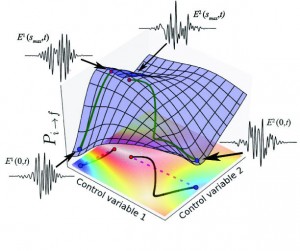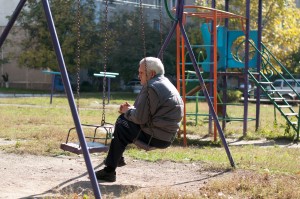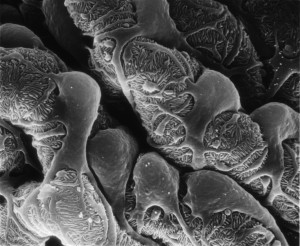
By B. Rose Huber, Woodrow Wilson School of Public and International Affairs
A new study by Princeton University researchers shows that people are actually biologically responsive to taking pleasure in the pain of others, a reaction known as “Schadenfreude.”
Ph.D student Mina Cikara took up the topic of Schadenfreude after she wore a Boston Red Sox hat to a New York Yankees baseball game. Nicknames and vulgarities were among the souvenirs she took home. And, after hearing about the name-calling and heckling her then-PhD student endured, Princeton professor Susan Fiske was compelled to join her in pursuing the phenomenon further, exploring why people fail to empathize with others based on stereotypes.
Through a series of four experiments – one involving the aforementioned sports rivalry – the researchers found that people are actually biologically responsive to taking pleasure in the pain of others, a reaction known as “Schadenfreude.” By measuring the electrical activity of cheek muscles, the researchers show that people smile more when someone they envy experiences misfortune or discomfort. While these findings hold significance for interpersonal relationships, the researchers also cite associated policy implications, such as how other countries view and stereotype the United States especially given that many countries envy the U.S., Fiske said. Their findings were reported in The Annals of the New York Academy of Sciences.
“Jealousy and envy are highly correlated,” said Fiske, coauthor of the study and the Eugene Higgins Professor of Psychology and Public Affairs in the Woodrow Wilson School. “When we ask people on surveys who is envied in American society, they report the same groups: objects of jealousy. This is all very much based on stereotypes. And so, in this study, we sought to better understand who is among these envied groups and whether that envy and jealousy elicits a harmful response.”
“We were interested in the conditions under which people fail to empathize with one another and how, for some of those people, they experience happiness at another’s expense,” said lead author Cikara, now an assistant professor at Carnegie Mellon University. “We wanted to start in a place where people would be willing to express their opinions and willingness to harm more freely, like we see in sports. We asked ourselves: what is it about rivalries that elicit a harmful response? And can we predict who will have this response?”
In the first experiment, the researchers examined participants’ physical responses by monitoring their cheek movements with an electromyogram (EMG), which captures the electrical activity of facial movements when an individual smiles. Participants were shown photographs of individuals associated with different stereotypes: the elderly (pity), students or Americans (pride), drug addicts (disgust) and rich professionals (envy). These images were then paired with everyday events such as: “Won five dollars” (positive) or “Got soaked by a taxi” (negative) or “Went to the bathroom” (neutral). Participants were asked how this would make them feel, and their facial movements were recorded.
“Because people don’t like to report envy of Schadenfreude, this was the best method for gathering such responses. And, in this experiment, we were able to viscerally capture malicious glee,” Fiske said. “We found that people did smile more in response to negative than positive events, but only for groups they envied.”
In their second experiment, the researchers used self-reporting and functional magnetic resonance imaging (fMRI) – which measures blood flow changes associated with brain activity – to determine whether participants were willing to harm certain groups. Participants viewed the same photographs and events as the first study and were asked to rate how they felt on a scale of one to nine (from extremely bad to extremely good). Similar results emerged: Participants felt the worst about positive events and the best about negative events in regards to the rich professionals. Two weeks later, the researchers followed up with an online survey in which the participants were presented a scenario-based game that involved the option to hurt another person, such as through electric shocks in order to spare several others.
“People were willing to hurt an envy target, saying, ‘Yes, let’s shock her,'” Cikara said. “We found that surprising because we weren’t certain participants would self report that. While it’s true that people are generally averse to harming others, the bottom line is that people don’t feel this way all the time.”
Manipulating stereotypes was the goal of the third experiment. Using various scenarios regarding an investment banker as an example, the researchers threw counter-stereotypic information at participants. In one article, the banker was himself, employed and status quo. In another, he was advising clients pro-bono (eliciting pride). In the next, he was using his work bonuses to buy drugs (disgust) and, finally, he was unemployed but still dressing to go to work (pity). Again, the findings matched earlier experiments – participants rated the articles associated with disgust and envy with less warmth than the pride or pity scenarios.
“This experiment shows that the dimensions predicting envy are high status and competition, and, when you move those around, the envy goes away. This is consistent with the story about who gets envied and why. A lot of it is tied into money because that’s an easy thing to look at,” said Fiske.
In the final experiment, the researchers used Cikara’s experience – a game between the Boston Red Sox and New York Yankees. Both groups of fans were prescreened for “intense fandom.” Participants were again monitored through fMRI and self-reports after watching a series of plays in which opponents struck out, scored runs or made fantastic plays. As predicted, participants reported experiencing more pleasure during positive outcomes for their team.
When a third neutral team – the Baltimore Orioles – was thrown into the mix, the fans reported little to no reaction to positive or negative events and did not wish to cause Orioles fans harm. But they were happy when their rival team lost to the Orioles, showing pure Schadenfreude, said Fiske. An online survey completed by participants two weeks later showed that both groups of fans were more likely to heckle, insult, threaten or hit a rival fan while watching the plays.
“We used a sporting event because it’s something you can bottle,” said Fiske. “Rabid fans are passionate about it, and we were looking for an intergroup phenomenon that reaches people where they live. This is certainly it. But it’s important to remember that this study isn’t just about sports teams. It’s about intergroup rivals of more consequence.”
Fiske thinks of the study as a simulation or model of group envy or harm.
“In our larger model of stereotypes, we find that when things go smoothly, people go along to get along with these envied groups. It’s when the chips are down that these groups become real targets of Schadenfreude.”
In terms of policy implications, Fiske and Cikara agree there are many.
“Around the world, the American government is seen as high status and competent but not necessarily as a group sharing other people’s or countries’ goals. So, as far as other people are concerned, we’re the world’s bullies, and we have data that show that,” said Fiske. “And so, if we want to work with another country, it’s not the respect we’re lacking; it’s the trust. We need to remember that these stereotypes really affect how we enter other settings.”
“A lack of empathy is not always pathological. It’s a human response, and not everyone experiences this, but a significant portion does,” Cikara said. “We need to remember this in terms of everyday situations. If you think about the way workplaces and organizations are set up, for example, it raises an interesting question: Is competition the best way to get your employees to produce? It’s possible, in some circumstances, that competition is good. In other ways, people might be preoccupied with bringing other people down, and that’s not what an organization wants.”
Funding for the work was provided by the Russell Sage Foundation, the Princeton Neuroscience Institute, Princeton’s Center for Human Values, WWS’s Joint Degree Program in Social Policy and the Charlotte Elizabeth Procter Fellowship (awarded to Cikara by Princeton University).
Mina Cikara and Susan T. Fiske. Their pain, our pleasure: stereotype content and schadenfreude. Annals of the New York Academy of Sciences. 2013. Vol. 1299 Sociability, Responsibility, and Criminality: From Lab to Law. Pages v–x, 1–100. Article first published online: 24 SEP 2013. DOI: 10.1111/nyas.12179





You must be logged in to post a comment.